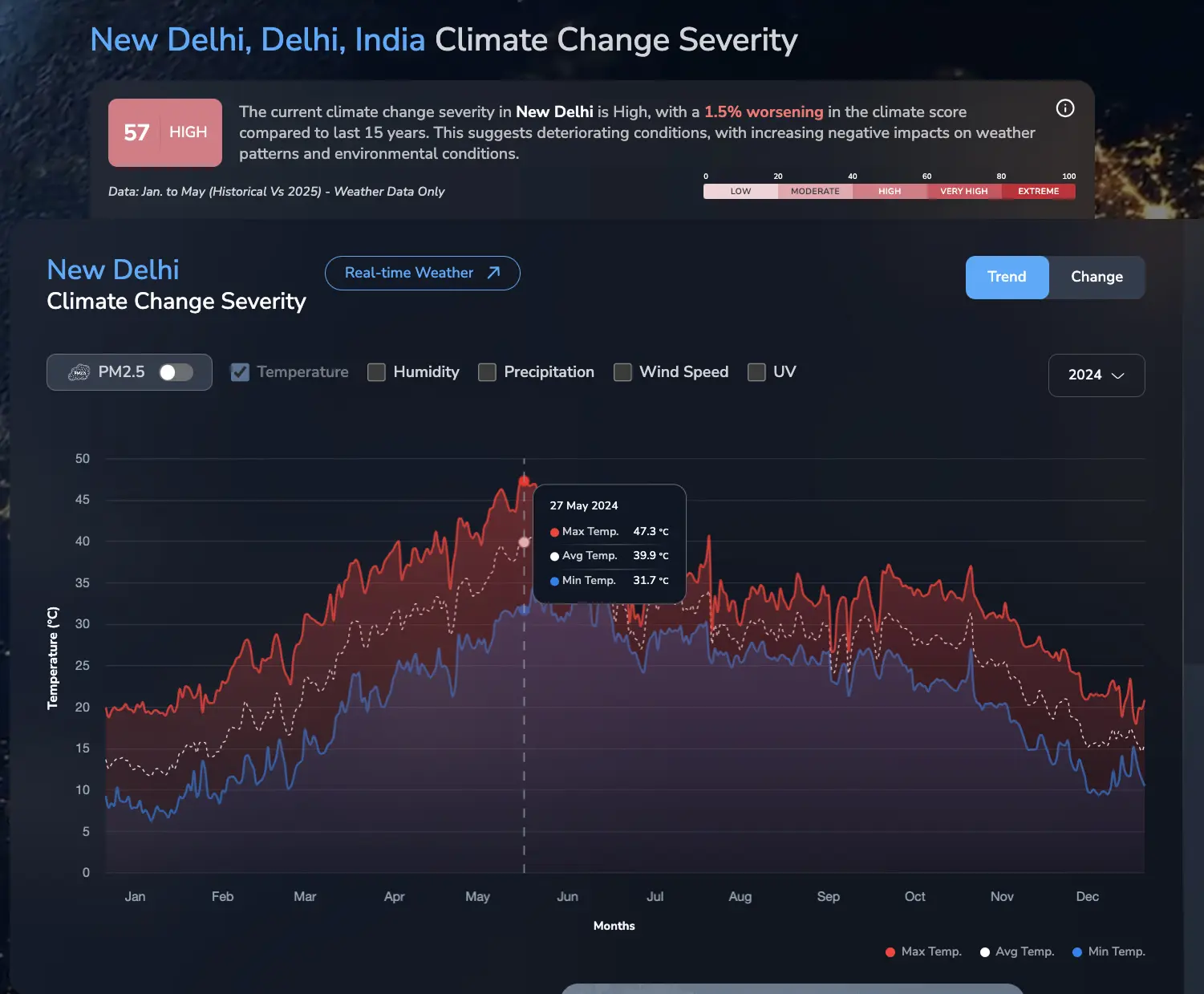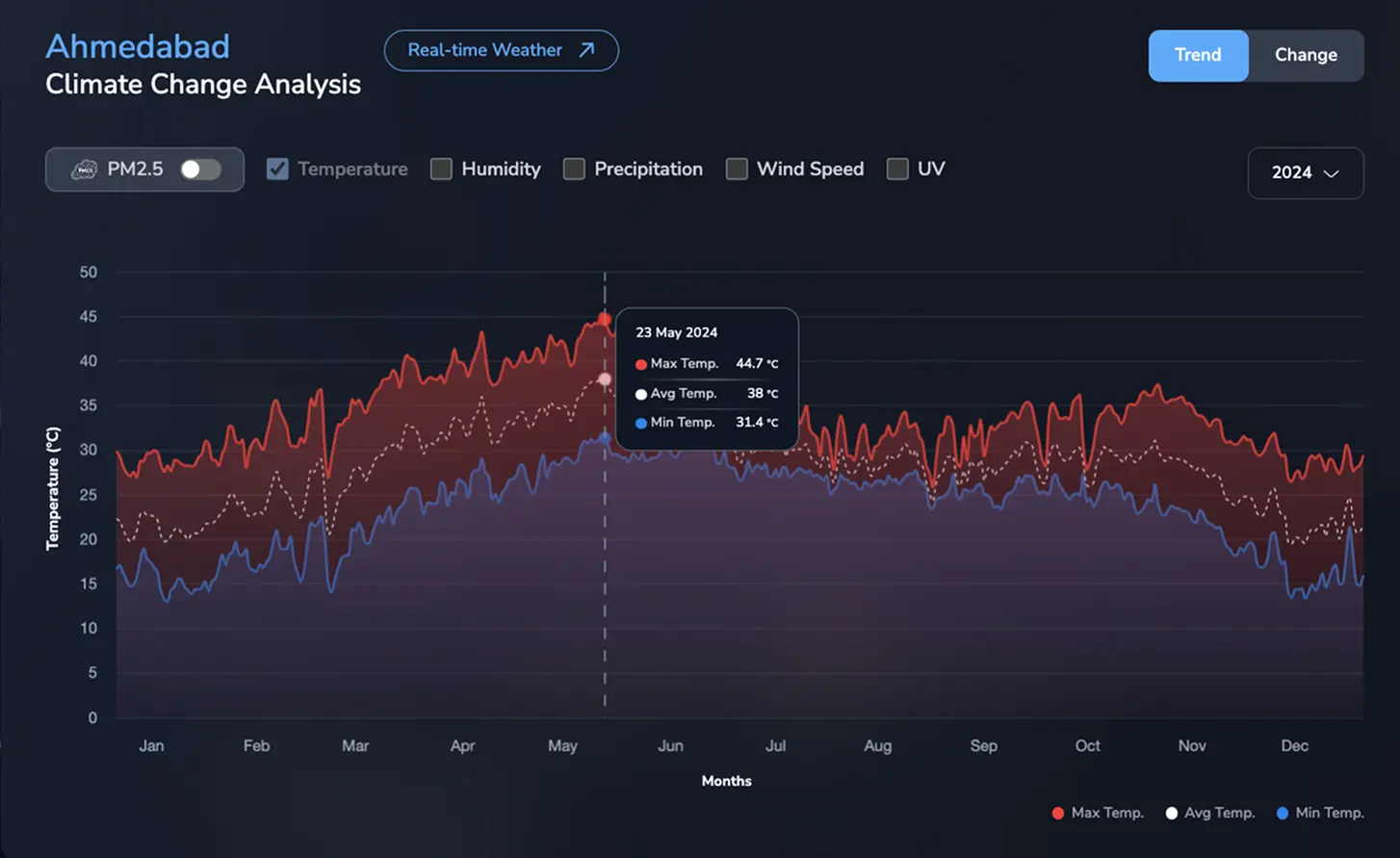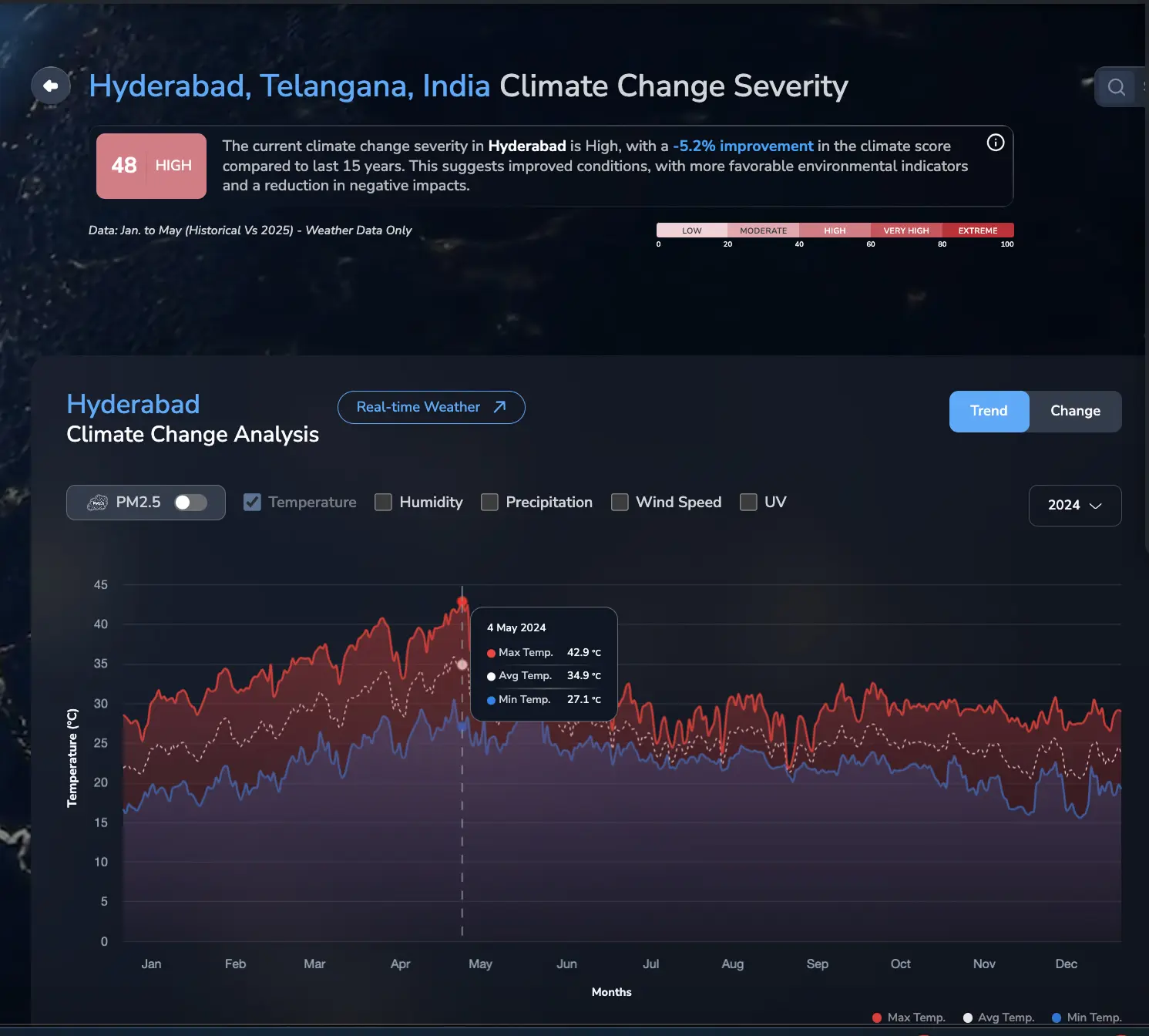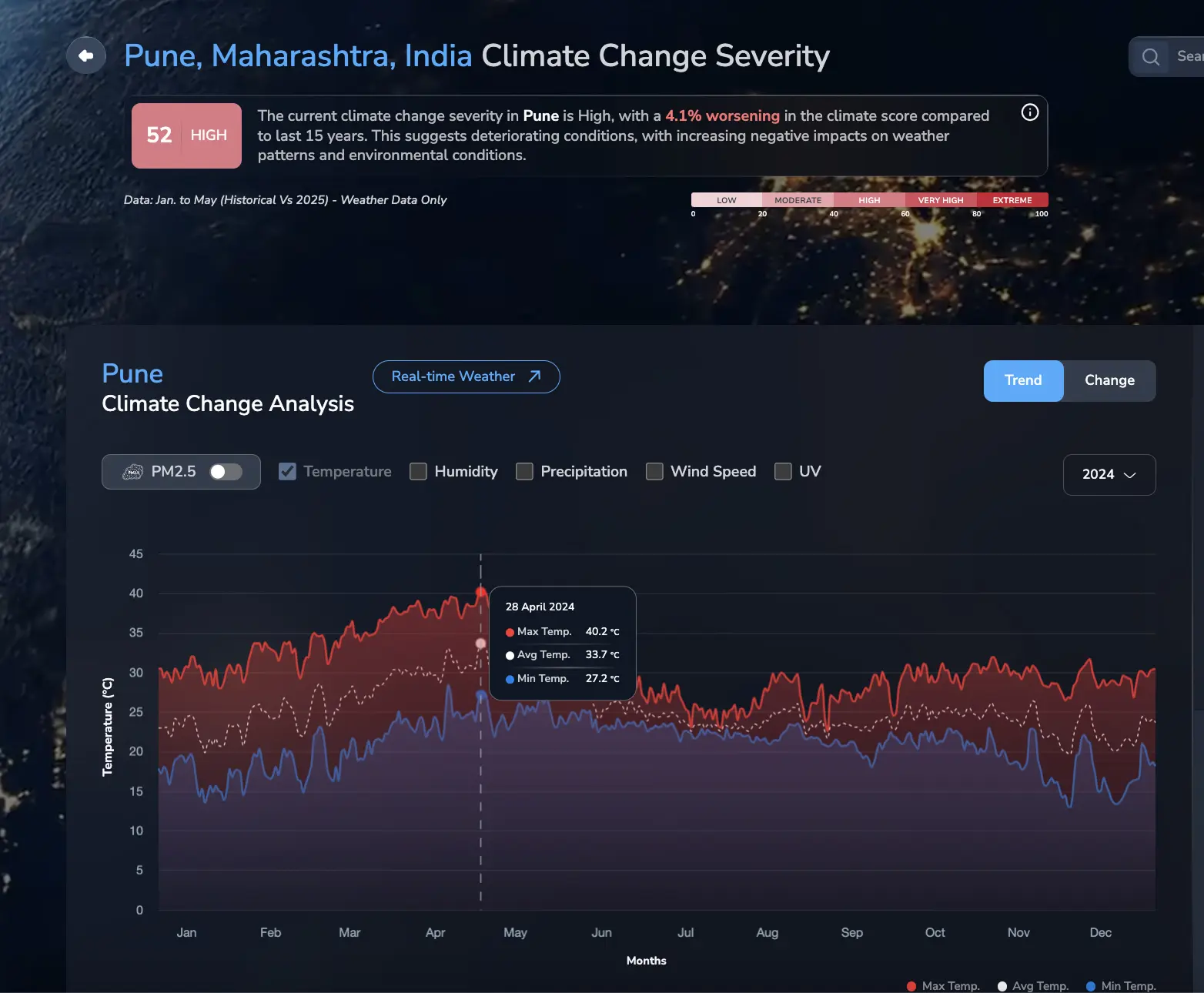In recent decades, the rapid urbanization of Indian cities has fundamentally transformed their microclimates. Tall buildings, expanding road networks, diminishing green spaces, and dense human activity have altered how heat is absorbed, retained, and released. This change has given rise to a phenomenon known as the Urban Heat Island (UHI). It is an increasingly urgent issue as cities experience record-breaking temperatures amid global climate change. Do you know that Urban Heat Islands in India are increasing? Here are the temperature and climate change data of the top 5 metro cities of 2024 to understand the change.
What are Urban Heat Islands in India?
The Urban Heat Island effect refers to the rise in temperature in urban areas compared to surrounding rural or suburban zones. Cities, built largely with heat-absorbing materials such as asphalt, concrete, and metal, trap solar radiation throughout the day. As evening sets in, this stored heat is slowly released, making urban environments significantly warmer, especially during the night.
Natural surfaces like soil, vegetation, and water bodies help regulate temperature by reflecting sunlight and facilitating evapotranspiration. When these are replaced with buildings and roads, the ability of the environment to cool itself is greatly diminished. In addition, the high concentration of vehicles, air conditioners, industries, and human activity releases waste heat that contributes further to this warming.
The UHI effect doesn’t just make cities uncomfortable — it endangers public health, raises energy consumption, degrades air quality, and widens inequalities. And with climate change pushing baseline temperatures higher, its effects are becoming more severe and persistent.
2024: A Year of Record Heat in India’s Metro Cities
According to temperature and climate severity data gathered during India’s peak summer months in 2024, cities like New Delhi, Ahmedabad, Hyderabad, Mumbai, and Pune have witnessed extreme heat events that reflect the growing intensity of UHIs. While each city has its own geographical and climatological factors, all are facing amplified warming due to unchecked urban growth.
Let’s look at how these five major Indian metros are being affected in 2024.
New Delhi: The Epicenter of Urban Heat Stress

New Delhi recorded a scorching 47.3°C on May 27, 2024 — one of the highest ever temperatures in the city’s history. More alarming is the city’s average daily temperature of 39.9°C, which reflects sustained high temperatures rather than a few isolated heat spikes.
The climate severity index, based on combined heat factors and worsening trends, placed Delhi at 57, the highest among all major cities analyzed. This also came with a +1.5% increase in severity compared to last 15 years.
Delhi’s UHI problem is a consequence of dense urbanization, reduced green cover, and an enormous number of heat-emitting sources, including traffic, air conditioners, and industrial units. With limited wind corridors due to unplanned construction and a declining number of trees, the city essentially traps heat during the day and retains it at night, making recovery periods shorter and heat exposure more dangerous for residents.
Ahmedabad: No Relief, Day or Night

Ahmedabad’s maximum temperature reached 45.4°C on May 23, with average temperatures hovering around 38.3°C. Perhaps more tellingly, the minimum temperature at night was recorded at 31.2°C, suggesting that the city is not cooling off sufficiently after sunset — a classic symptom of the UHI effect.
While Ahmedabad lacks a specific severity score in this dataset, its heat profile strongly suggests increasing vulnerability. Nighttime heat retention can be even more dangerous than daytime highs, as it offers little physiological relief, especially for vulnerable groups such as the elderly, outdoor labourers, and low-income residents who lack access to air conditioning.
In recent years, Ahmedabad has experimented with heat action plans and cool roofing projects. But the scale of the challenge in 2024 suggests that adaptation efforts are still not keeping pace with the intensity of the crisis.
Hyderabad: Mixed Signals in the Climate Fight

Hyderabad recorded a high of 42.9°C on May 4. Its climate severity index stood at 48, yet it showed a –5.2% improvement over the 15 years, the most significant reduction among major Indian cities.
While Hyderabad is undoubtedly facing high temperatures, its improving severity score suggests that mitigation efforts, such as lake restoration, increased tree plantation, and sustainable construction policies, may be beginning to show results. The city’s topography — with scattered hills and water bodies — also contributes marginally to moderating extreme heat.
Still, Hyderabad’s cooling trend should be interpreted with caution. The current maximum temperatures remain dangerously high, and if unchecked urban growth continues, even this modest progress could be reversed.
Mumbai: The Unique Case Among Urban Heat Islands in India

Mumbai offers a unique case. The city’s maximum temperature peaked at 37.0°C in mid-April, relatively lower than landlocked metros. However, its minimum temperature was 27.1°C, one of the highest among all cities, and its climate severity index matched Hyderabad’s at 48, with a marginal 1.7% improvement compared to the last 15 years.
Mumbai’s coastal location provides some buffering against extreme highs, but humidity levels are exceptionally high. The UHI effect in Mumbai manifests more through uncomfortable and persistent heat, particularly at night. This is exacerbated by the city’s vertical growth, congested neighbourhoods, and declining mangrove ecosystems.
What’s more, the UHI effect here is deeply inequitable — while air-conditioned high-rises can manage heat, the large slum population faces heat exposure that is both constant and inescapable.
Pune: Losing Its Cool Reputation

Once known for its mild climate, Pune’s 2024 temperature data tells a different story. The city saw a high of 40.7°C in late April, and its climate severity index rose to 52, with a troubling +4.1% increase from 2010 to 2024.
This data paints a picture of a city slipping into dangerous territory. As Pune’s IT sector expands and real estate booms, green spaces are being rapidly converted into commercial and residential blocks. Without effective zoning, tree conservation, or climate-smart architecture, Pune risks becoming a textbook case of how unchecked development can erase natural climate advantages.
Which City Is the Biggest Urban Heat Island in India in 2024?
To determine which city is currently experiencing the most intense Urban Heat Islands in India effect, we must examine a combination of peak temperatures, average and minimum temperatures, and the climate change severity index. These indicators reveal not just how hot a city gets, but how consistently high the heat remains, especially at night — a hallmark of the UHI phenomenon.
Here’s a comparative snapshot based on 2024 data:
| City | Max Temp (°C) | Avg Temp (°C) | Min Temp (°C) | Climate Severity Index | Severity Change 2010-2024 |
| New Delhi | 47.3 | 39.9 | 31.7 | 57 | +1.5% |
| Ahmedabad | 45.4 | 38.3 | 31.2 | 52 | Not significant |
| Hyderabad | 42.9 | 34.9 | 27.1 | 48 | –5.2% |
| Mumbai | 37.0 | 32.5 | 28.8 | 48 | –1.7% |
| Pune | 40.7 | 32.2 | 26.1 | 52 | +4.1% |
While all five cities exhibit serious UHI characteristics, New Delhi tops the chart as the most critical Urban Heat Island in India in 2024. Its intense temperatures across the board, high severity score, and continued growth without significant mitigation measures make it ground zero for urban heat risk in the country.
Conclusion: A Warning and a Window of Opportunity
The data from 2024 makes one thing clear: India’s urban centers are facing a compounded heat crisis — a result of both global climate change and local urban mismanagement. The Urban Heat Islands India effect magnifies this crisis, turning cities into heat traps where both day and night temperatures threaten health, productivity, and quality of life.
Of the five cities analyzed:
- New Delhi leads in overall severity and urgency.
- Ahmedabad shows dangerous nighttime temperatures.
- Hyderabad offers hope through modest improvement.
- Mumbai illustrates the dangers of persistent humidity and heat stress.
- Pune highlights how even temperate cities are becoming heat hotspots.
To reverse or contain this trend, cities must adopt aggressive climate resilience strategies — not just policy-driven, but ground-level interventions such as green roofing, heat-resilient infrastructure, protected urban forests, and public awareness campaigns.
As temperatures continue to rise, the urgency for action cannot be overstated. Urban India stands at a tipping point. What it chooses to do in the next few years will define whether its cities become resilient centres of life or ovens of inescapable heat.